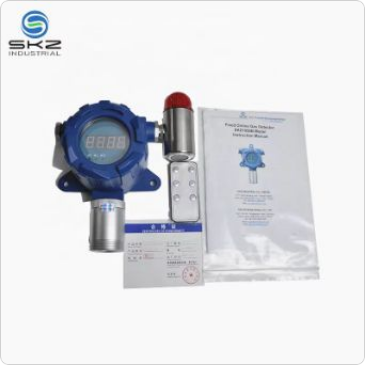The Critical Role of Home Gas Monitors in Modern Safety
Common Household Gas Threats
It is important to know what potential gas hazards there are within your home in order to keep a safe and healthy home. You’ve all heard of carbon monoxide, it’s known as the “silent killer” because you live so well with it; no one can see or smell it. Highly flammable natural gas and propane are often used in heating systems and kitchen appliances, and can escape from appliances and piping Kidde Nighthawk Plug-In Carbon Monoxide Detector. Articles from reliable sources such as the National Fire Protection Association (NFPA), and the Centers for Disease Control and Prevention (CDC) might also make it clear just how frequently gas leaks occur in homes throughout the U.S. Almost 20,000 Americans visit emergency rooms annually with symptoms of carbon monoxide poisoning, so early warning is essential. During gas exposure even physical sensations like dizziness, headache, and nausea are possible and clearly show the significant importance to detect gas quickly with proper gas monitoring instruments.
Consequences of Undetected Gas Leaks
Undetected gas leaks are more than just a physical threat. Long-term exposure can cause serious health problems, including respiratory problems and neurological damage. It is a fact that experts keep warning us to be vigilant with gas levels within homes. While there are some known instances of dangerous gas leaks being the cause of devastating explosions, now you can protect your home with the First Alert Explosive Gas and Carbon Monoxide Alarm. The monetary impact of these leaks is significant, from repair expenses to potential legal implications, and higher insurance rates. For example, victims of major gas leaks could have tens of thousands of dollars in damage and repairs to make their house it safe once who families where affected by bad gas leak emergencies. Thus, purchasing good home gas monitors is not only preventative but also a practical fiscal measure to ensure that the costs in the long run does not go colossal.
Types of Gas Detection Systems for Residential Use
Fixed Gas Detectors: Permanent Protection Solutions
Fixed gas detectors are indispensable devices for continuous monitoring of a range of dangerous gases in domestic environments. They are permanently installed in homes and monitor leaks as soon as they happen. These detectors are placed in locations that makes sense (often the top part of a room near the ceiling) because some gases, such as methane, are known to rise. They are easy to install aside from that, but for optimal use and placement, they can often require professionals to come out and set them up. Fixed Gas Detectors come with a number of benefits over their portable counterparts, mainly, as they constantly monitor air quality they have better reliability and cheaper maintenance cost (as they don't have to be moved on a regular basis or checked)
- A study from the NFPA highlights that fixed detectors are exceptionally effective at identifying gas leaks early, potentially preventing dangerous situations from arising.
- Statistics show that homes equipped with fixed detectors report fewer gas-related incidents, reinforcing their critical role in residential safety.
Portable Gas Detectors: Mobile Safety for Comprehensive Coverage
Portable gas detection is used in work areas where pollution levels are constantly changing. Unlike permanent detectors, portable detectors can be carried around the house or take on a picnic, offering live information on gas levels from different areas. They are a valuable addition when renovating a home and gas lines may be temporarily re-landscaped or modified. Hiking and camping trips enjoy the benefit of portable detectors so that you can be sure about safety while handling gas-powered appliances.
- Experts suggest integrating portable detectors with fixed systems for a comprehensive gas monitoring solution. This ensures thorough coverage and maximizes safety in different scenarios.
- Choosing portable detectors for situations where immediate mobility is required provides added security and peace of mind.
Hybrid Systems: Combining Fixed and Portable Technologies
Hhbr8 systems, integrating both the fixed and portable gas-detection solutions, can provide the most comprehensive security for larger houses. They improve the ability to detect beyond the capabilities of single systems. Because the most effective mosquito control needs to be comprehensive when treating a property, hybrid systems use both fixed nozzles to cover the most difficult spots with a steady application and take-home units for occasional or prompt treatment.
- Popular hybrid systems on the market include advanced features that cater to diverse user needs. Consumer reviews frequently praise these systems for their wide coverage, reliability, and user-friendly interfaces.
- These systems are especially useful for providing comprehensive safety in extensive properties, ensuring every corner can be monitored for potential gas leaks effectively.
Through integrating fixed, portable, and hybrid systems, homeowners can enjoy unrivaled residential safety, staying vigilant against gas leaks through constant and adaptable protection strategies. Utilizing comprehensive detection systems will ensure peace of mind and significantly reduce the risks associated with household gas threats.
Essential Features for Effective Gas Monitoring
Advanced Sensor Technology for Accurate Detection
Today's gas monitors use some of the most advanced sensor technology to provide a huge amount of accuracy when it comes to detection. These detectors, typically using electrochemical, infrared and catalytic sensors, respond more sensitively to gas leaks compared to older detectors. People in the industry point out the new sensors are a quantum leap from mere minutes to sense gases, and offer much more dependability than just gas monitors of old. Industry certifications, such as from the American Gas Association, highlight the capabilities of technologies such as these, showcasing an increase in response time and detection sensitivity. It is this technological enhancement which gives homeowners a much greater capacity to respond rapidly and effectively to potential gas leaks.
Multi-Alert Systems: Audible, Visual, and Smart Notifications
Gas monitors with multialarm systems that help respond quickly to emergencies are essential. They do so by combining audible alarms with visual indicators such as flashing lights and by sending smart notifications to mobile devices. Research has indicated that these kinds of all-inclusive notification systems result in quicker response times, improving safety during gas emergencies. In addition, the connection of gas monitors to smart home systems enhance optimization, offering remote alert monitoring and gas concentration data in real time. This also seamlessly integrates, allowing gas detection to be efficient.
Durability and Environmental Resistance
The sensitivity and stability of the gas detectors need to be good enough for long time operation. They must resist moisture, dirt and temperature variations, to prolong their life and ensure reliabilty. There are industry standards like the IP Rating System that define standards for how tough the gas monitors have to be to resist things like the elements. Top models, such as those made by Kidde and First Alert, receive high marks for durability, based on user reviews and on the trial-by-fire product testing. These systems guarantee generations of peak performance to help keep our communities safe from dangerous gas related disasters long after we're gone.
---
Transitioning from the essential features for effective monitoring, understanding the types of gas detection systems for residential use further presents customizable solutions tailored to specific needs.
Home Gas Monitor Installation and Maintenance: Unveiling Best Practices
Optimal Placement Strategies for Maximum Coverage
Proper positioning of Gas Monitors are a key factor in good gas detection in the home. For Whole-House protection it is highly recommended that if you intend to use this product to protect your whole house you use (1) plug-in unit in the room with the source of the gas and on every floor of your home as well as in your garage for gas leaks or in your kitchen, close to your stove top or range and near where your gas furnace can be found, (1) plugin unit near your gas hot water heater and as many more as necessary to provide all rooms in your home with complete coverage. Different gases are heavier or lighter and travel closer to or farther from the floor, for example, natural gas rises and propane settles close to the floor. Hence, the mounting height should consider such features for maximum performance. Moreover, safety agency experts frequently recommend not positioning within vicinity of windows, fans, or HVAC vents so as to avoid any gas dilution effects. By adhering to these tips, homeowners can improve their gas monitors' responsiveness, and precision.
Calibration Protocols for Long-Term Reliability
Periodic calibration of gas monitors is necessary to ensure that they remain accurate and dependable over time. Calibrating reads align the device with industry standards, making the readings accurate and perfect for finding gas leaks. Homeowners should adhere to manufacturer recommendations, which typically include bi-annual calibrations and regular testing, to maintain the sensitivity of the device. When it isn't properly calibrated, it doesn't detect gas leaks or gives false alarms. Therefore maintaining an appropriate calibration procedure is critical in long-term reliability of a gas monitor.
Integrating Gas Monitors with Existing Safety Ecosystems
Combining gas monitors with smoke and other existing home safety systems such as security alarms can establish a well rounded safety plan. “With OmniTracs Video, we're leveraging new technology to deliver optimal fleet protection, and ensuring that there are no safety gaps in the event of an incident,” said Ray Greer, president and chief operating officer, Omnitracs. '<%=RememberToTag>`This bundled offering is designed to improve safety safety and have access to combined warnings and coordinated responses to emerging threats.’.replaceAll('aware','safety') ”. This function is available on many of the newer systems and allows for integration with smart home platforms which can send push notifications to your phone and allow you to control your gear from your smartphone. Homeowners say those configurations are easier to maintain and provide more peace of mind, turning all of the systems’ devices into an interconnected safety web. Procurement of compatible systems and impartial advice will enable you to incorporate gas monitoring within a total approach to home safety.
FAQ
What are the most common gases that pose a threat at home?
Carbon monoxide, natural gas, and propane are the most common gases in homes that pose significant threats due to their explosive and poisonous nature.
Why is it crucial to have a gas monitor in homes?
Gas monitors help detect leaks early, preventing health hazards, property damage, and financial losses associated with gas-related incidents.
How do fixed gas detectors differ from portable ones?
Fixed gas detectors are installed permanently to monitor specific areas continuously, while portable detectors are mobile, providing real-time data in various locations for flexible safety coverage.
What features should I consider in an effective gas monitor?
Key features include advanced sensor technology for accurate detection, multi-alert systems for comprehensive notifications, and durability to withstand environmental factors.
How often should gas monitors be calibrated?
Most manufacturers recommend calibrating gas monitors bi-annually and conducting regular tests to ensure accuracy and reliability.

